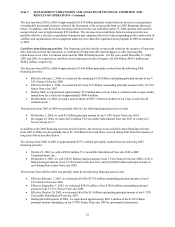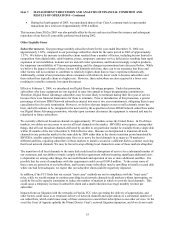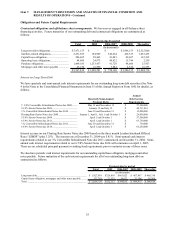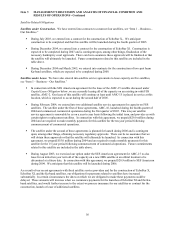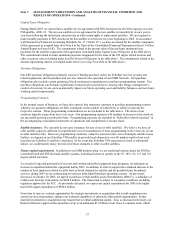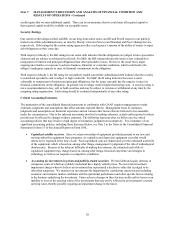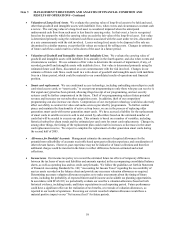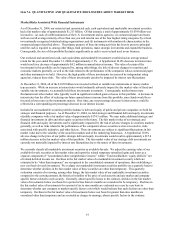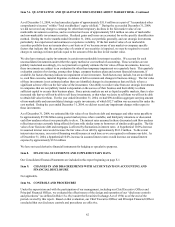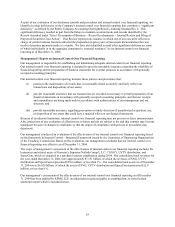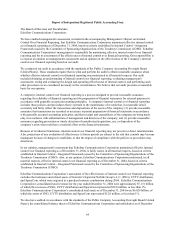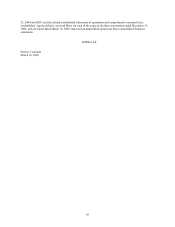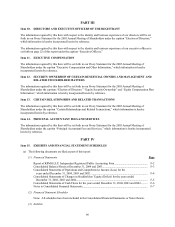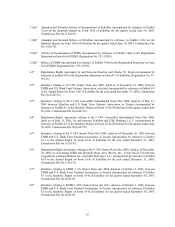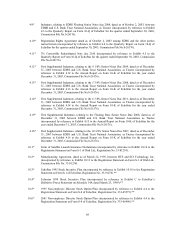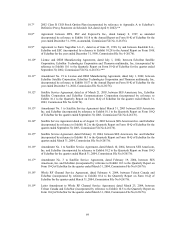Dish Network 2004 Annual Report Download - page 70
Download and view the complete annual report
Please find page 70 of the 2004 Dish Network annual report below. You can navigate through the pages in the report by either clicking on the pages listed below, or by using the keyword search tool below to find specific information within the annual report.Item 7A. QUANTITATIVE AND QUALITATIVE DISCLOSURES ABOUT MARKET RISK - Continued
62
As of December 31, 2004, we had unrealized gains of approximately $51.8 million as a part of “Accumulated other
comprehensive income” within “Total stockholders’ equity (deficit).” During the year ended December 31, 2004,
we did not record any charge to earnings for other than temporary declines in the fair market value of our
marketable investment securities, and we realized net losses of approximately $9.0 million on sales of marketable
and non-marketable investment securities. Realized gains and losses are accounted for on the specific identification
method. During the twelve months ended December 31, 2004, our portfolio generally, and our strategic investments
particularly, has experienced and continues to experience volatility. If the fair market value of our marketable
securities portfolio does not remain above cost basis or if we become aware of any market or company specific
factors that indicate that the carrying value of certain of our securities is impaired, we may be required to record
charges to earnings in future periods equal to the amount of the decline in fair market value.
We also have strategic equity investments in certain non-marketable investment securities. We account for such
unconsolidated investments under either the equity method or cost method of accounting. These securities are not
publicly traded and accordingly, it is not practical to regularly estimate the fair value of these investments, however,
these investments are subject to an evaluation for other than temporary impairment on a quarterly basis. This quarterly
evaluation consists of reviewing, among other things, company business plans and current financial statements, if
available, for factors that may indicate an impairment of our investment. Such factors may include, but are not limited
to, cash flow concerns, material litigation, violations of debt covenants and changes in business strategy. The fair value
of these investments is not estimated unless there are identified changes in circumstances that are likely to have a
significant adverse effect on the fair value of the investment. Our ability to realize value from our strategic investments
in companies that are not publicly traded is dependent on the success of their business and their ability to obtain
sufficient capital to execute their business plans. Since private markets are not as liquid as public markets, there is also
increased risk that we will not be able to sell these investments, or that when we desire to sell them we will not be able
to obtain full value for them. For the year ended December 31, 2004, we had $90.4 million aggregate carrying amount
of non-marketable and unconsolidated strategic equity investments, of which $52.7 million was accounted for under the
cost method. During the year ended December 31, 2004, we did not record any impairment charges with respect to
these investments.
As of December 31, 2004, we estimated the fair value of our fixed-rate debt and mortgages and other notes payable to
be approximately $5.924 billion using quoted market prices where available, and third party valuations or discounted
cash flow analyses when it was practicable to do so. The interest rates assumed in these discounted cash flow analyses
reflect interest rates currently being offered for loans with similar terms to borrowers of similar credit quality. The fair
value of our fixed-rate debt and mortgages is affected by fluctuations in interest rates. A hypothetical 10.0% decrease
in assumed interest rates would increase the fair value of our debt by approximately $161.2 million. To the extent
interest rates increase, our costs of financing would increase at such time as we are required to refinance our debt. As
of December 31, 2004, a hypothetical 10.0% increase in assumed interest rates would increase our annual interest
expense by approximately $35.6 million.
We have not used derivative financial instruments for hedging or speculative purposes.
Item 8. FINANCIAL STATEMENTS AND SUPPLEMENTARY DATA
Our Consolidated Financial Statements are included in this report beginning on page F-1.
Item 9. CHANGES IN AND DISAGREEMENTS WITH ACCOUNTANTS ON ACCOUNTING AND
FINANCIAL DISCLOSURE
Not applicable.
Item 9A. CONTROLS AND PROCEDURES
Under the supervision and with the participation of our management, including our Chief Executive Officer and
Principal Financial Officer, we evaluated the effectiveness of the design and operation of our “disclosure controls
and procedures” (as defined in Rule 13a-15(e) under the Securities Exchange Act of 1934) as of the end of the
period covered by this report. Based on that evaluation, our Chief Executive Officer and Principal Financial Officer
concluded that our disclosure controls and procedures are effective.


